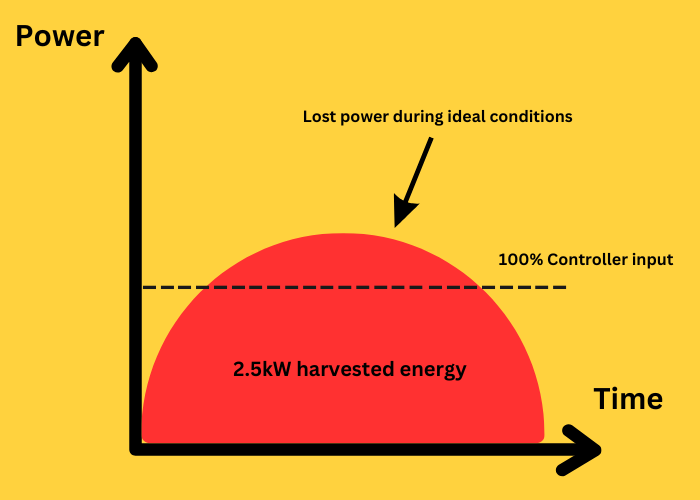Overpaneling refers to connecting more solar panels to a solar charge controller than its rated input power.


This is often done to capture more solar energy during less-than-ideal conditions, such as cloudy or overcast days.
Solar charge controllers are designed to handle a certain amount of power coming from the solar panels. For example:
50A charge controller * 12V battery = 600W of solar
It is said that you should not have more than 600W of solar in this case.
People fear that having more than 600W of panels will damage the solar charge controller.
However, most solar charge controllers have built-in protection that will limit the charging current to max 50 Amps.
Instead of limiting the solar array to 600W, you can use 800W as well.
800W/12V=66A
66A will be capped of at 50A, because this is the maximum charging current of the charge controller.
However, you might only reach 66A during the summer. Where you would already have enough sun, and the batteries are always fully charged.
We use overpaneling to get more energy during winter and cloudy days.

Input Voltage
The input voltage of a solar charge controller is a hard limit. This means that you cannot go over the maximum input voltage listed on the charge controller. To calculate the maximum input voltage, use the following equation:
Voc * 1.25 = Max input voltage
For example, three solar panels have a Voc of 22V each.
22V * 1.25 * 3 panels = 82.5V
If you have a charge controller with a maximum input of 100VDC, you can only use three solar panels in series with a Voc of 22V. You can add more solar panels in parallel to expand your solar array.
Input Current
Check the datasheet of your solar charge controller for the maximum input current. Victron labels this as max pv short circuit current.

Output Current
When over-paneling, the solar charge controller will limit the current it delivers to its maximum rated capacity. This means that even if the solar panels can produce more power, the controller will only accept what it can handle. This is why overpaneling doesn’t typically harm the controller.
However, there are a few things to keep in mind when considering overpaneling:
- Efficiency: Overpaneling can be less efficient because the extra power produced by the solar panels when the sun is at its peak is not used.
- Cost: Overpaneling means investing in more solar panels, which increases the overall cost of the solar system.
- Space: More solar panels require more space, which might not be available in some installations.
- Legal and Safety Regulations: Some regions have regulations about how much overpaneling is allowed due to safety concerns. Always check local regulations and consult with a professional before overpaneling.
Pros and Cons of Overpaneling your Solar System
Pros of Overpaneling
- Maximized Energy Capture: Overpaneling allows you to capture more solar energy during less-than-ideal conditions, such as cloudy or overcast days. This can be particularly beneficial in regions with less consistent sunlight.
- Better Winter Performance: Solar panels produce less power in the winter due to shorter days and lower sun angles. Overpaneling can help compensate for this reduced output.
Cons of Overpaneling
- Wasted Energy: When the sun is at its peak, the extra power produced by the overpaneled system is not used because the charge controller limits the current it accepts to its maximum rated capacity.
- Increased Costs: Overpaneling requires more solar panels, which increases the initial investment cost of the solar system. This can be offset by saving money on another charge controller.
- Space Requirements: More solar panels require more installation space. This can be a limiting factor if space is at a premium. For example, I do not recommend overpaneling if you live in an RV or boat.
- Potential for Overheating: If the solar charge controller doesn’t have a mechanism to limit the current it accepts, overpaneling could cause the controller to overheat, leading to damage or reduced lifespan.
- Regulatory Limitations: Some regions have regulations limiting the degree to which a system can be overpaneled, due to safety and grid stability concerns. If you are off-grid, this isn’t a concern.
Conclusion
Overpaneling can be beneficial to maximize solar energy capture, particularly in less-than-ideal conditions. However, it’s important to consider factors such as efficiency, cost, space, potential for overheating, and regulatory limitations. Always ensure your solar charge controller can handle the increased input and consult with a professional to make the most informed decision for your specific needs.
[custom-related-posts title=”Related Posts” none_text=”None found” order_by=”title” order=”ASC”]
I’m an off-grid enthusiast. I created this website to give clear and straight-to-the-point advice about solar power. I’m also the author of the book ‘Off-grid solar power simplified‘. Read more about me on my about page, check out my Youtube channel, or send me a message.
how do you know if the the solar charge controller doesn’t have a mechanism to limit the current it accepts or not ?
It will be in the datasheet if there is a current limit.